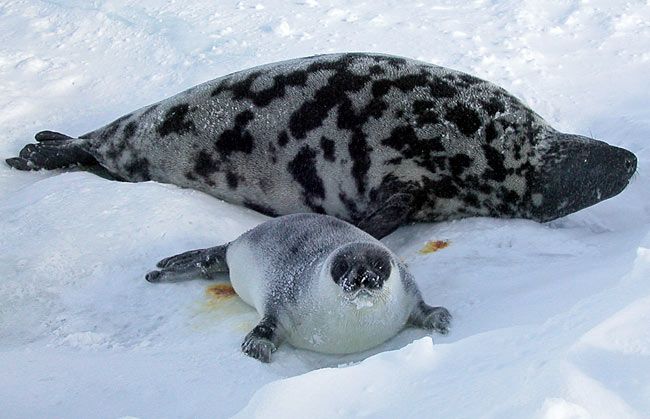Another Hooded Seal Mystery Revealed

Hooded seals are shrouded in mystery. They emerge from the North Atlantic Ocean onto ice flows only four days each year, where they birth pups, nurse them and breed in one go—then wander the Atlantic for thousands of miles, as far south as the Panama Canal.
But wildlife scientists have unveiled another curiosity about the marine mammals: It’s impossible to tell one population from the next by comparing their DNA.
The seals' lack of genetic diversity, detailed in a recent issue of the journal Molecular Ecology, offers clues about their evolutionary past and should help ecologists conserve the animals.
Super sampling
Two main breeding populations of hooded seals exist in an immense region of hundreds of thousands of square miles: One in Canadian waters and the other off Greenland’s coast. But when it comes to pegging any one seal's birthplace, wildlife geneticist David Coltman is stumped. “Give me any animal—a deer, a fish, a goat, even a human. I can tell you where it came from,” Coltman told LiveScience. “With the hooded seal, I can’t.”
The finding seems contradictory, Coltman explained, because splitting a species across huge regions generally promotes differences in an animal’s genetic code. Case in point—harp seals occupy the same chilly territories as hooded seals and can be identified to a region using DNA analysis.
To find out just how genetically similar they were, Coltman and his team sequenced DNA from hundreds of hooded seal tissue samples collected during the past two decades.
Sign up for the Live Science daily newsletter now
Get the world’s most fascinating discoveries delivered straight to your inbox.
“It’s the biggest collection ever put together,” Coltman said, co-author of the study. “And, unlike 20 years ago, we now have the tools to make sense of it.”
But the team also harvested their own samples—a process which can be a hair-raising experience. “Hooded seals look cute, but they will try to kill you,” Coltman said. “It’s dangerous to go onto the ice with them.”
Mysterious origins
Coltman can’t be sure what caused hooded seal’s “flat” genetic diversity, but his best guess retraces the freezing and thawing of Earth during the last Ice Age.
“The ice would have pushed their habitat down to the equator,” forcing them breed in one location, he said. As the ice retreated, they kept the panmictic, or globally-interbreeding, behavior we see today instead of typical migratory behavior.
“The little genetic diversity we see is a sign of rapid recolonization,” Coltman said. In other words, the seals populated northern regions in as little as 10,000 years—when the Ice Age ended—so their breeding behavior hasn’t yet changed to the surroundings.
And they might never, Coltman said, given their ability to travel. “Hooded seals really do exchange a lot of individuals between populations,” he said.
Immediate impact
Coltman explained that the first impact of the study will be in conservation of the hooded seal, which people hunt for pelts, blubber and meat.
“If you knock down the numbers too much in one population, there may not be enough individuals to recover from the loss,” he said. But instead of two smaller populations to manage, conservation agencies will have one global population—a much greater challenge due to the level of country-to-country cooperation required.
But hooded seal experts like Coltman aren’t completely fixated on managing hooded seal populations. The researchers want to use the finding as a springboard for another hooded seal mystery: How mother seals lose 20 percent of their body weight to pups, which gain about 60 pounds in just four days.
“It’s an incredible feat,” Coltman said. “We’re all interested in trying to understand how they do it, because it could help us better understand obesity.”
- Young Seal Strandings Puzzle Biologists
- Rogue Seal Menacing Man, Beast in California
- Fishermen: Too Many Seals












